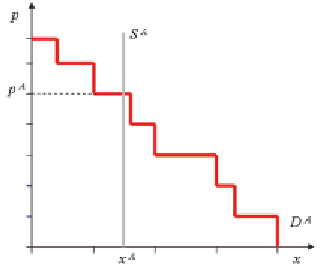Environmental Engineering Reference
In-Depth Information
Figure 4. Auctioning without secondary market
trading
ances
x
A
is allocated to the bids with reservation
prices above or equal to
p
A
.
In the absence of arbitrage barriers Figure 5
introduces the price discovery function of liquid
secondary markets. It derives the secondary mar-
ket clearance price
p
S
as the intersection of the
secondary markets aggregated demand curve
D
S
with negative price elasticity and the markets
aggregated supply curve
S
S
with positive price
elasticity. The frictionless and costless opportu-
nity for bidders to satisfy their demand by buying
in either or both of the secondary market and
primary market auctions implies that the demand
curve
D
A
*
in a scenario with secondary markets
is truncated. Consequently, the auction price
p
A
*
should never be above the price
p
S
observed in
secondary markets. In fact, the auction clearing
price should always be somewhat lower than the
secondary market clearing price to compensate
for the lack of immediacy in auctions compared
to continuous secondary market trading.
Obviously, primary market auctioning and
secondary market price discovery are intertwined.
Assuming efficient secondary markets and the
absence of arbitrage barriers between the two,
clearance of primary market auctions will be
determined by secondary market price discovery
and liquidity. We provide some insight on the
question whether our strong assumption on sec-
ondary market efficiency holds for the EU ETS
is no difference in accessibility and transaction
costs and there is no difference in the contracts
auctioned and traded in the secondary markets.
Without loss of generality, let us also assume
that primary market auctions are implemented
as repeated sealed-bid single-price auctions and
that the full amount of allowances is auctioned,
i.e. there is no free allocation.
Figure 4 illustrates the clearance of such an
auction when there is no secondary market. The
market's aggregated demand curve
D
A
with
negative price elasticity meets the auctioneer's
inelastic supply curve
S
A
. The auction results in
a clearance price
p
A
where - unless there is in-
sufficient demand - the total amount of allow-
Figure 5. Auctioning with secondary market trading


